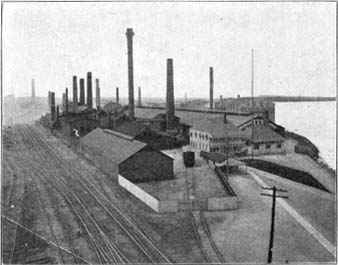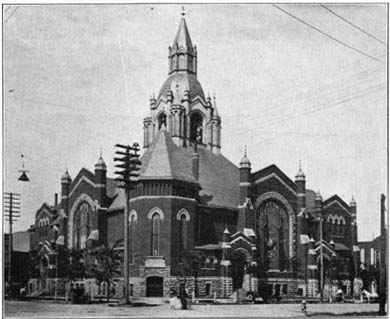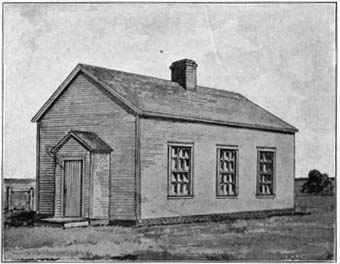chiefly upon the question of railroad influence in state politics and the personality of the nominees for governor. J. H. Mickey received 96,471, W. H. Thompson 91,110, S. T. Davies, prohibitionist, 3,397, G. E. Bigelow, socialist, 3,157. The republicans elected a three-fourths majority of both houses of the legislature. The all-consuming question before the legislature was the framing of a new revenue law. The many interests involved made this a difficult problem. The bill which finally became law made a number of radical changes, among them the substitution of a county assessor with a force of deputies for each county, instead of the old precinct assessor system, a more rigid and searching form of schedule and oath to secure the assessment of personal property, the listing of property at its full cash value, and its assessment for taxation at one-fifth thereof, and the granting of additional power to county and state boards of equalization. A new state institution was established,--an additional normal school which was located at Kearney. 
American Smelting and Refining Company's Buildings,
Omaha A branch experimental state farm was located at North Platte. A system of junior or summer state normal schools was established, an act requiring railroads to give elevator firms or associations equal shipping privileges, and an act to compel the destruction of prairie dogs by the owners of the land where the dog towns were located. |
of Utah and Washington. By the act of February 28, 1861, Colorado was organized, cutting out a part of the southwest corner of Nebraska. Idaho was organized in March, 1863, taking that part of Nebraska west of the 104th degree of longitude,--our present western limit. In 1882 the triangular tract between the Niobrara, the Keya Paha, the Missouri, and the 43rd degree of latitude was added to Nebraska and became subsequently Boyd county. Since then the only changes in Nebraska's boundaries have been slight ones along the Missouri river, the result of changes in its channel and negotiations with Iowa, Missouri and South Dakota. 
St. Paul's Church, Lincoln, Nebraska, 1901 earliest art association we have record of is a "sketch class" started by Mrs. Charles F. Catim, at Omaha in 1877. In 1879, the first art loan exhibition was held in Omaha. In 1888 Mr. Lininger of Omaha began the erection of his private gallery, which is now opened to the public each week, and contains some $200,000 worth of original paintings--many of them masterpieces of European as well as Amercan art. In 1890 the Omaha art exhibition association was formed, which is carrying on its work today. The beginnings of art instruction at the state university were in the year 1880, when room was granted for the use of an art teacher who received private pupils. In 1888 the Hayden Art Association was formed at Lincoln to be succeeded ten years later by the Art Association, which holds annual exhibitions of noted pictures in the University Art Gallery. |
chiefly in its newspaper form. Some of the ornaments of Nebraska newspaper life in the use of clear, epigramatic English have been J. D. Calhoun, formerly of the Lincoln journal, now of Tampa, Florida; Fred Nye, formerly of the Omaha Republican; Ed Howe, now of the Atchison Globe; Edward Rosewater of the Omaha Bee, C. H. Gere of the Lincoln Journal, R. L. Metcalfe of the Omaha World-Herald, Ross Hammond of the Fremont Tribune, Ernest Bross, how managing editor of the Portland Oregonian; Walter Wellman, now of the Chicago Record-Herald. Among Nebraska poets and essayists, may be noted Prof. O. C. Dake, author of Nebraska Legends--the first book of Nebraska poetry known to have been printed; N. K. Griggs of Lincoln; Mrs. Peattie, formerly of Omaha, A. L. Bixby of the Lincoln Journal; Walt Mason of the Beatrice Summary; J. A. Edgerton, now of New York City; Kate M. Cleary, formerly of Hubbell, a writer of stories of Nebraska life; W. R. Lighton, of Omaha, a magazine writer on Ne- 
First Church Built in Lincoln, 1868 braska themes. Some additional Nebraska newspaper men who have written literature are John A. MacMurphy, for a long time writer on the Omaha Herald; Allen May, of Falls City; Adam Breed, of Hastings, and Edgar Howard of Columbus. |
of forty-five sister states, which forms the strongest nation in the world--her rank is tenth in total value of farm products, eighth in the production of wheat, fourth in the production of corn, fourth in number of cattle and swine, third in manufacture of meat products, and first of all in education qualification of her people. In fifty years Nebraska has given the world its central battle ground for the settlement of the most pressing world problems, from slavery to monopoly; she has given national leadership to both sides in these struggles; she has given the nation twice a leading candidate for president, she has given the world an Arbor day. Highest of all, her broad prairies and lofty table lands, have given birth to a race of clear visioned, independent minded, progressive men and women. Unfettered by the dogmatism of the past in politics, in religion, in economics, in human sympathy and aspiration, may Nebraska never fail in her leadership. |
 |
 |
 |
 |
|
@ 2002 for the NEGenWeb Project by Pam Rietsch, Ted & Carole Miller |
|||